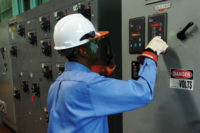FR fabrics that prioritize breathability are essential for warmer months

With the summer months right around the corner and temperatures warming up around the US, workers in a variety of industries are making adjustments to their personal protective apparel kit. The mornings of pulling on coveralls and packing an extra layer are gone and now, workers are evaluating what apparel they have available that will help keep them comfortable even when standards require they remain covered up on the job.
But before you can decide which fabrics are the most breathable, it’s important to understand what the term even means. In its most uncomplicated form, breathability simply refers to how much air and moisture a fabric allows to pass through it.
Now, if an employee is requesting FR apparel that is more “breathable” it’s likely they’re looking for options to help keep them cool. When that’s the case, there’s more to consider than just “breathability.”
First, take note of the construction and weight of the material. In general, thinner materials can affect breathability positively so it’s best to avoid apparel made with a tight knit construction. Next, many manufacturers have moisture management technologies, like moisture wicking and quick-dry, that can advance the breathability of a fabric. Lastly, consider color. Dark colored clothing has been known to absorb heat from the sun, which may elevate internal temperatures and cause the wearer to become hot and uncomfortable. Choosing lighter colored clothing can help keep the wearer cooler in the long run when outdoors.
As a starting point, below are three fabric options that can be engineered to prioritize breathability.
Cotton
As one of the most universal fabrics, cotton can be found in a variety of applications; however, it’s important to note that 100% cotton, non-FR fabrics are not recommended for those facing thermal hazards specifically.
Polyester
If you’re looking at traditional activewear, it’s likely that you’ll find polyester as a part of the material makeup. That’s thanks in part to its ability to wick moisture and dry quickly. The same holds true for FR fabrics. When evaluating FR options, consider blends that include polyester.
Modacrylic
This modified acrylic fiber is flame resistant so when evaluating options, fabrics with modacrylics are something to consider; however, the manufacturer choice is going to play a large role in whether the modacrylic blend is breathable.
With advancements in FR technologies, traditionally heavy garments have evolved to become more lightweight and breathable, too, like FR denim. These denim options don’t just provide durability but are designed to be lightweight, prioritizing comfort on the job. If your workers’ needs don’t adhere to traditionally breathable fabrics, talk to your manufacturing partner about what innovations they’ve made within heavy garments.
Industrial workers who require FR protection don’t have to sacrifice comfort simply to stay protected. When considering options, look for a manufacturer that prioritizes aesthetics and worker satisfaction just as much as industry requirements and standards.
As a reminder, always put safety standard compliance at the top of your list before considering additional fabric benefits. Personal protective equipment, no matter how breathable, is only effective if it properly protects the worker from the threats they face.
Looking for a reprint of this article?
From high-res PDFs to custom plaques, order your copy today!









